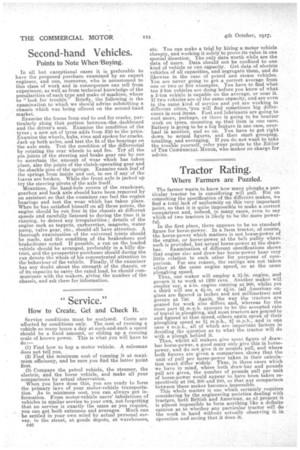Tractor Rating.
Page 12

If you've noticed an error in this article please click here to report it so we can fix it.
Where Farmers are Puzzled.
The farmer wants to know how many ploughs a particular tractor he is considering will pull. But on consulting the specification of the different makes, we find a total lack of uniformity on this very important point, so that it is quite impossible to make a correct comparison and, indeed, in many cases, even to say which of two tractors is likely to be the more powerful.
In the first place, there appears to be no standard figure for horse-power. In a farm tractor, of course, the horse-power which matters is not horse-power of the engine, or horse-power at the belt pulley where such is provided, but actual horse-power at the drawbar. Examination of different specifications shows that engine size and draw-bar horse-power bear very little relation to each other for purposes of comparison. For one reason, the ratings are not taken either at the same engine speed, or at the same ploughing speed.
Thus, one maker will employ a 312-in. engine, and govern it to work at 1200 revs. Another maker will employ say, a 4-in, engine running at 900, whilst yet a third will use a *in. or 4i-in, (all American engines are figured in inches and not millimetres) and govern at 750. Again, the way the tractors are geared for work also differs and, whereas for the most part 21 m.p.h. appears to be the accepted rate of travel in ploughing, and most tractors are geared to and figured at that speed, others again sneak of their ploughing speed as 2,1 m.p.h., 2/ m.p.h., and in one case 4 m.p.h., all of which are important factors in deciding the question as to what the tractor will do with a plough behind it. Then, whilst all makers give some figure of drawbar horse-power, a good many only give this in horsepower, and do not give it in nounds pull, and where both figures are given a comparison shows that the unit of pull per horse-power taken in their calculation must differ widely. Thus, in three eases which we have in mind, where both draw-bar and pounds pull are given, the number of pounds pull per unit of horse-power would appear to, have been taken respectively at 184, 200 and 240, so that any comparison between these makes becomes impossible. This whole matter is one which certainly requires considering by the engineering societies dealing with tractprs, both British and American, as at present it is almost impossible to form anything like a definite opinion as to whether any particular tractor will do the work in hand without actually observing it in operation and seeing that it does it.
























